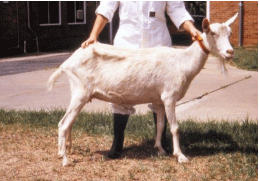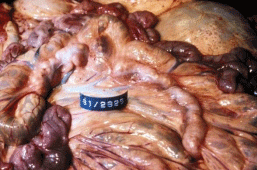Johne’s Disease in Goats
Published: March 1, 2015
By: By Dr Sandra Baxendell, PSM, BVSc (Hons), PhD MANZCVSc, GCertAppSC(RurExt), GCertPSect
Mgt, PGDAppSc, MRurSysMan
Director, Goat Veterinary Consultancies –goatvetoz
Johne’s disease (pronounced “Yo Knees”) is an incurable wasting disease of adult goats. There are 2 distinct strains of Johne’s disease in Australia - the bovine or cattle strain and the sheep or ovine strain. These are generally referred to as BJD and OJD. Unfortunately goats can get both, although BJD is the more common. Johne’s disease is related to the one that causes tuberculosis, another chronic wasting disease, but affecting the lungs instead of the gut.
The Responsible Bacteria
The bacteria responsible for Johne’s disease is Mycobacterium paratuberculosis and is closely related to the bacteria that causes tuberculosis. Research has shown that the bacteria can survive for a couple of months in the soil but if the soil is moist then it is possible for the bacteria to survive up to 12 months. For this reason if destocking or quarantining, then 2 summers are needed to be sure that no bacteria can survive on any property.

The bacteria turn the goat’s gut into a bacterial production factory and these go out in the goats’ faeces and infect other animals.
Clinical Signs
Clinical signs can be very slow to show up and initially the goat or other ruminant, will start to shed bacteria in the faeces long before any signs show.

Later the clinical signs are wasting, rough coat and only sometimes towards the end of life, some scouring or loose faeces. Often affected goats just look like a “wormy” or “skinny” goat.
Post-Mortem Signs
The signs can be easily missed and if present, enlarged gut lymph nodes are an indication of Johne’s disease. In order to be sure, it is necessary to send many samples away to a laboratory. The samples are specified on page 65 of the MAP Manual. The photo below shows a line of enlarged lymph nodes below the small gut. The gut lining is sometimes thickened and with obvious folds

How can I ensure my goats never get this disease?
Only buy goats (sheep, alpacas, llamas or cattle) from herds in the official Market Assurance Program (MAP) for Johne’s disease. Three year accreditation is better than one year and is better than check tested. You can search for herds at this website http://edis.animalhealthaustralia.com.au/pub lic.php?page=mapsearch&aha_program=3
If buying a property on which to keep goats, check if it has been used by ruminants and their Johne’s disease status – or buy a horse property.
Improving your goat herd hygiene helps reduce the spread but won’t prevent Johne’s disease i.e. never feed goats on the ground (use troughs instead), provide clean water without faecal contamination, quarantine new goats until tested for disease carrier status, and try not to mix goats of different age groups. Also every dead goat found soon enough, should be post-mortemed so that the cause of death can be identified.
Treatment
There is NO treatment.
Vaccination
While there is a vaccination registered for cattle and for sheep, these do not provide full protection and cannot even guarantee that vaccinated animals will not shed the bacteria. The vaccine can cause serious reactions at the site and also are very dangerous if accidently injected into the human handler. Neither vaccines are registered for goats, although a veterinarian, who has done the compulsory online training, can prescribe vaccine “off label” for goats. Also once vaccination has commenced in a herd, only faecal samples, no blood samples can be used to advance to the next level in the Market Assurance Program (MAP). Vaccinated herds have “V” after their MAP level.
Why bother? Vaccination can slow the spread of Johne’s disease in the herd and also increases the age of goats before clinical signs occur, reducing the economic loss.
How do I find an accredited vet?
Only an accredited veterinarian, who has done the online training, can help you gain MAP accreditation. You just need to search the database for such a vet in your town. https://apav.animalhealthaustralia.com.au/ index.php?page=searchvet
Further Information
MAP Manual for Johne’s Disease in Goats http://www.animalhealthaustralia.com.au/wp -content/uploads/2011/04/GoatMAPmanual.pdf
Facebook page for goat disease info– https://www.facebook.com/goatvetoz National Goat Health Statement - (www.animalhealthaustralia.com.au/wpcontent/uploads/2011/04/GHS_form.pdf)
National Kid Rearing Plan - (http://www.animalhealthaustralia.co m.au/national/kid/rearing/plan )
Slideshare presentations on Johne’s disease (http://www.slideshare.net/SandraBaxendell)
These US sites:
http://www.johnesdisease.org/#
and http://www.johnes.org/#
and this video
http://www.johnes.org/presentations/Diagno sis/Maine-DVMs-Cases.m4v
and a free online course for goat owners http://johnes.org/presentations//General/Go ats/Goats.html
Authors:
Recommend
Comment
Share

Would you like to discuss another topic? Create a new post to engage with experts in the community.









